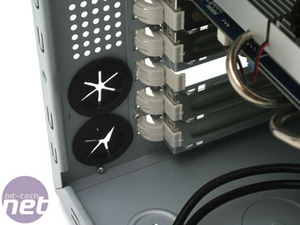Rawr!
On the other side of the case we can see that the usual ATX design is followed; PSU up top and drive bays down bottom.The HDD cage is mounted at the front of the case, at the bottom so it’s at the farthest possible point away from the PSU. The cage is ventilated with a black 120mm fan which funnels air quietly through the HDD cage and towards the PCI slots of the motherboard. The whole HDD cage sits about a centimetre off the base of the case.
The Poseidon comes packaged with all the usual extras, including HDD rails and brass standoffs, as well as a cool beige cleaning cloth with which to make sure the aluminium finish is nicely buffed.
Handily, the case also comes packed with adhesive cable clips and cable ties that can be used to fix stray cables to the case walls or to just reduce general cable clutter. It makes a nice alternative to just lumping spare wires together with an elastic band and bunging them in an unused drive slot.
The Poseidon has another fan on the back, but this time it’s a white 120mm made by Gigabyte which comes with a blue LED in it which lights up nicely and can be seen through the side window, whether it be filled with grill or window. Of course, if fan cooling isn’t your bag then the Poseidon comes with some rubberised ports for water-cooling setups which, given the name of the case, is probably the best choice. You don’t want to annoy the gods, after all.
The back of the case also makes use of a tool-less design on the drive bays, which can be opened by pressing down on the white catch. These catches were a bit hit and miss though and are a prime example of where a tool-less system can fail as it just doesn’t provide the security and precision of a screw or thumbscrew. With this tool-less design, if the catch doesn’t quite clip in properly or if the card you’re installing is slightly bent on the metal then the fit won’t be perfect, which isn’t ideal.
Our first glance at the Poseidon’s insides also made us worry about size constraints. Obviously it’s large enough to accommodate a standard motherboard, but whether it’s large enough to make room for big, burly man-hands at the same time is another matter altogether. Having enough room for us to get our hands in without having to perform some RSI inducing wrist-yoga is always preferable, but there’s no way we can really test for this without installing a system into the chassis and seeing how it goes.
So, we did that.

MSI MPG Velox 100R Chassis Review
October 14 2021 | 15:04













Want to comment? Please log in.